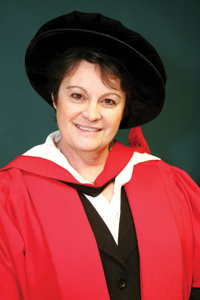Quality of life: The value of numbers
27 July 2009 Quality of life: Prof Jennifer Jelsma.
Quality of life: Prof Jennifer Jelsma.
At first glance it may seem little more than a statistician's vanity to put an actual number value to the quality of life, but as Professor Jennifer Jelsma illustrated in her inaugural lecture, The quality of life may be more important than life itself: but how do we quantify it?, on 15 July, there are many good reasons for doing so.
Jelsma, head of UCT's Division of Physiotherapy, showed that the merits of quantifying the health-related quality of life (HRQoL) make good sense. Quality of life, as a concept, is too broad for some purposes; for one thing, HRQoL proves more than handy in planning health interventions and policy.
"If we can't measure outcomes," said Jelsma, "then we're not going to expend resources on improving those outcomes."
Jelsma then looked at the pros and cons of two systems used to measure HRQoL - the Global Burden of Disease (GBD) measure, and the EQ-5D instrument.
She reported that a study she and colleagues had conducted in Zimbabwe had quickly exposed some telling shortcomings of the GBD. For starters, it didn't always reflect the concerns of specific groups.
Jelsma found, for example, that the GBD (and local Zim health professionals) rated conditions such as migraines, dementia and quadriplegia as the most burdensome. Yet township residents viewed dementia, as a case in point, as a natural part of life, and were far more worried about conditions related to infertility, which scored low on the GBD.
"Local people felt that having a child was far more important than many disabilities," said Jelsma.
The more numerically-nuanced EQ-5D - a measure Jelsma and colleagues contributed to - not only takes such cultural variation into account, but is also more flexible. While the GBD would, for example, assign the same value to amputation before and after treatment (so why treat?), EQ-5D and its scoresheet, known as EQ-5D-Y, compute even relatively small changes in health status.
It was a study in the UK using EQ-5D - which showed that Brits rated a number of conditions as being a fate worse than death - that inspired the title of Jelsma's lecture.
Jelsma and colleagues have since used the EQ-5D, which they've translated into both Shona and isiXhosa, for an early study on the use of anti-retrovirals to treat HIV, and on a wellness programme for factory workers. In both cases the EQ-5D, when used to measure outcome, led to higher quality self-reported HRQoL.
 This work is licensed under a Creative Commons Attribution-NoDerivatives 4.0 International License.
This work is licensed under a Creative Commons Attribution-NoDerivatives 4.0 International License.
Please view the republishing articles page for more information.









